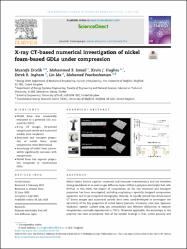X-ray CT-based numerical investigation of nickel foam-based GDLs under compression

View/
Date
2024Author
Erçelik, Mustafaİsmail, Mohammed S.
Hughes, Kevin J.
Ingham, Derek B.
Ma, Lin
Pourkashanian, Mohamed
Metadata
Show full item recordCitation
Ercelik, M., Ismail, M.S., Hughes, K.J., Ingham, D.B., Ma, L., Pourkashanian, M. (2024). X-ray CT-based numerical investigation of nickel foam-based GDLs under compression. International Journal of Hydrogen Energy, 50, pp. 1338-1357. https://doi.org/10.1016/j.ijhydene.2023.07.001Abstract
Nickel foams feature superior structural and transport characteristics and are therefore strong candidates to be used as gas diffusion layers (GDLs) in polymer electrolyte fuel cells (PEFCs). In this work, the impact of compression on the key structural and transport properties has been investigated, including employing a specially designed compression apparatus and X-ray computed tomography. Namely, 20 equally spaced two-dimensional CT based images and numerical models have been used/developed to investigate the sensitivity of the key properties of nickel foams (porosity, tortuosity, pore size, ligament thickness, specific surface area, gas permeability and effective diffusivity) to realistic compressions normally experienced in PEFCs. Wherever applicable, the anisotropy in the property has been investigated. One of the notable findings is that, unlike porosity and ligament thickness, the mean pore size was found to decrease significantly with compression. The mean pore size is around 175 μm for uncompressed nickel foam and it decreased to around 110 μm for a 20% compression ratio and to around 70 μm for a 40% compression ratio. Further, unlike the effective diffusivity, the gas permeability was shown to be highly anisotropic with compression; this fact is of particular importance for PEFC modelling where the properties of GDLs are often assumed isotropic. All the computationally estimated properties have been presented, validated and discussed.















